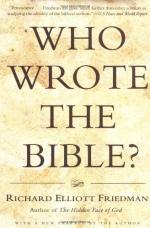
|
| Name: _________________________ | Period: ___________________ |
This test consists of 5 multiple choice questions, 5 short answer questions, and 10 short essay questions.
Multiple Choice Questions
1. Who does the evidence point to as the writer of Deuteronomy?
(a) an Aaronid of Hebron.
(b) a Mosaic priest of Jerusalem.
(c) a Levite of Shiloh.
(d) a non-priestly prophet.
2. Who writes his book in much the same way that Deuteronomy had been written?
(a) Samuel.
(b) David.
(c) Josiah.
(d) Jeremiah.
3. What does Friedman conclude about the Tabernacle after the first Temple was built?
(a) that it was used to cover the Temple.
(b) that the it actually existed inside the Holy of Holies.
(c) that it was set up behind the Temple.
(d) that it was burned to prevent idolatry.
4. When did the early scholars consider that Author D wrote?
(a) during the time of King Hezakiah.
(b) during the time of the fall of Israel.
(c) during the conquest of Canaan.
(d) during King Josiah's time.
5. What goes against the First Commandment?
(a) committing adultery.
(b) worshipping foreign gods.
(c) committing genocide.
(d) bearing false witness.
Short Answer Questions
1. What was so attractive about Wellhausen's summary?
2. What does Friedman suggest gives a clue as to the identity of the writer D?
3. What does Friedman suggest is the only good news about the exile?
4. How do Graf and others see the Tabernacle?
5. What is Freidman's analogy to the problem of the fall of Judah?
Short Essay Questions
1. What is problematic about the mistake in locating writer P in history?
2. Describe clues to who wrote Deuteronomy.
3. How was responsibility for the eventual exile of the people defined in the later text?
4. How does Friedman identify as writer R, the redactor who stitched together all the various versions into one Torah?
5. What does Friedman speculate held the Jewish people together, even during the exile?
6. At the rebuilding of the Temple, what is a major difference between it and the original Temple?
7. Why does Friedman finally identify Jeremiah as the author of Deuteronomy?
8. Explain how are D and E writers different from J and P authors?
9. How does Friedman react to the idea that the prophets did not know about writer P?
10. During what historical time frame does Friedman place the writer P?
|
This section contains 864 words (approx. 3 pages at 300 words per page) |

|




